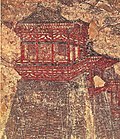Chang'an

Chang'an was the capital of ancient China of more than ten dynasties in Chinese history. Chang'an literally means "Perpetual Peace" in Classical Chinese. During the Xin Dynasty, the city was renamed "Constant Peace";[1] yet after its fall in the year 23 AD, the old name was restored. During the Ming Dynasty, the name was changed to its present name Xi'an, meaning "Western Peace".
History
The imperial city of Chang'an during the Han Dynasty was in northwest of today's Xi'an. During the Tang Dynasty, the area to be known as Chang'an included the area inside the Ming Xi'an fortification, plus some small areas to its east and west, and a major part of its southern suburbs. The Tang Chang'an was 8 times the size of the Ming Xi'an. During this time Chang'an was one of the largest and most populous cities in the world. Around 750 A.D. Chang'an was called a "million people's city" in Chinese records, while modern estimates put it at around 800,000–1,000,000 within city walls.[2]
In 710, the grid of Japan's capital city at Heijō-kyō was planned to mirror the grid of Chang'an.[3] In 794, the plan of the new capital at Heian-kyō also mirrored the Chang'an design.[4]
Chang'an Media
Que towers along the walls of Tang-era Chang'an, as depicted in this eighth-century mural from Li Chongrun's (682–701) tomb at the Qianling Mausoleum in Shaanxi
A terracotta horse head from the Han dynasty.
Map of Weiyang and Chang'an Palace, illustrated during the Qing dynasty
The Giant Wild Goose Pagoda, built in 652 AD, located in the southeast sector of Chang'an.
The Small Wild Goose Pagoda, built in 709 AD, damaged by an earthquake in 1556 but still standing, in the central sector of Chang'an.
References
- Benn, Charles (2002). China's Golden Age: Everyday Life in the Tang Dynasty. Oxford: Oxford University Press. ISBN 0-19-517665-0.
- Ebrey, Walthall, Palais (2006). East Asia: A Cultural, Social, and Political History. Boston: Houghton Mifflin Company. ISBN 0-618-13384-4.
- Ma, Dezhi. "Sui Daxing Tang Chang’an Cheng Yizhi" ("Archeological Site of Sui's Daxing and Tang's Chang'an". Encyclopedia of China (Archeology Edition), 1st ed.
- Wang, Chongshu. "Han Chang’an Cheng Yizhi" ("Archeological Site of Han's Chang'an"). Encyclopedia of China (Archeology Edition), 1st ed.
Further reading
- Steinhardt, Nancy Shatzman (1999). Chinese Imperial City Planning. Honolulu: University of Hawaii Press.
- Xiong, Victor Cunrui (2000). Sui-Tang Chang’an: A Study in the Urban History of Medieval China. Ann Arbor: University of Michigan Center for Chinese Studies.
Other websites
Coordinates: 34°16′N 108°54′E / 34.267°N 108.900°E
- ↑ (常安, pronounced the same way in Mandarin Chinese)
- ↑ (a)Tertius Chandler, Four Thousand Years of Urban Growth: An Historical Census, Lewiston, NY: The Edwin Mellen Press, 1987. ISBN 0-88946-207-0. (b) George Modelski, World Cities: –3000 to 2000, Washington DC: FAROS 2000, 2003. ISBN 0-9676230-1-4. However, Charles Benn (Benn, 46), Patricia Ebrey, Anne Walthall, and James Palais (Ebrey, 93) assert that Chang'an and the surrounding jurisdictions of the suburban countryside (the metropolitan area of Chang'an) had a potential population size of around 2,000,000 people. According to the census in the year 742 recorded in the New Book of Tang, 362,921 families with 1,960,188 persons were counted in Jingzhao Fu (京兆府), the metropolitan area including small cities in the neighborhood. (see New Book of Tang, vol. 41 (Zhi vol. 27) Geography 1.)
- ↑ Nussbaum, Louis-Frédéric. (2002). "Naniwa" in Japan Encyclopedia, p. 697.
- ↑ Nussbaum, "Heian-kyō" in Japan Encyclopedia, pp. 303-304.









